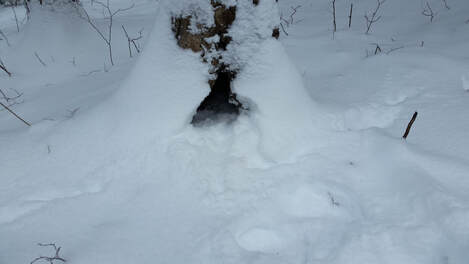 A sugar maple as a den tree in the Painted Post region. A sugar maple as a den tree in the Painted Post region. The Importance of Den Trees It would be hard to exaggerate the value of den trees. Undoubtedly, den trees—those trees which have become hollowed-out enough to allow a woodland critter to raise its young—are the critical shelter many woodland animals require to survive and are as valuable as food or water in the long-term. Further most (if not all) states see den trees (when the animal is fully or partially inside) as sanctuary from hunters. Fun note: whether the tree is truly a den tree, I can’t see the raccoon, or it’s training season, I use the command “den tree!” to call our coonhounds off the tree. They know that means it’s time to come off that particular tree and go look for another ringtail! Let me hasten to add that I’m the last person (as a woodland property owner) who wants to add more regulations or laws to control how landowners uses their property; certain restrictions on land use are common sense (one would hope), and there may be an instance where a den tree has to be removed for safety to life or property. Further, sometimes a family’s financial situation is such that they don’t have a choice but to use the resources at hand—I’m sympathetic in this case as will. That said—a little education may go a long way to influence what a property owner does with a den tree, and public land policy could also be amended (further) to safeguard this valuable resource. How Den Trees Form. You see—trees are not genetically disposed (although some species in a given area lean toward it), per se, to become a den tree. Most of the time, the formation of a den tree happens by circumstance—some accident (e.g., lightning strike, forest fire, another tree falling nearby that breaks off a limb, predation [e.g., porcupine gnawing on limb that kills the limb], etc.) initiates the process of hollowing out a tree. Then over (sometimes, many) years—disease causing rot of the weakened wood, insects (e.g., carpenter ants), woodpeckers, etc.—work on the hole, continuing to create the den. As the tree grows, and the interior den becomes larger, the tree can become the habitat for squirrels, raccoon, porcupine, and the (relatively newly returned to Upstate New York) fisher cat. In my experience, the majority of den trees are hardwood species, but I’ve also seen a considerable number of larger softwood trees that also provide suitable homes for woodland creatures. Why let the den trees stand? Besides what I’ve already said about the importance of raising young’uns, the timber value of den trees is lessened considerably (to practically zero in some cases) due to the hollow nature of the tree; i.e., there’s no solid log to be had. This is likewise true of the den tree viewed as a firewood source compared to a solid, non-den tree: You simply can’t burn the “hollow” in a den tree. (Note: if a den tree topples over on its own—yes by all means—cut it up for firewood. No sense in wasting anything!) So, I say—whenever possible—let the den trees stand. The land and its wildlife in your area will be better for it.
2 Comments
Ernest Stephens
2/26/2020 01:38:12 pm
Great read. Wish more people understood this.
Reply
Your comment will be posted after it is approved.
Leave a Reply. |
Categories
All
|
- Ryland Creek
- About The Ryland Creek Novels
- Buy the Ryland Creek Saga: Print Books
- Buy the Ryland Creek Saga in E-Book
- The Ryland Creek Saga in Audiobook
- Blog: In a place called Painted Post
- Reader Reviews for The Ryland Creek series
- Meet the Author:Joseph Gary Crance
- An Ode to Painted Post
- The Magical Realism of the Ryland Creek Saga
- Other local authors
- Contact
- Leave A Reader Review
- Ryland Creek
- About The Ryland Creek Novels
- Buy the Ryland Creek Saga: Print Books
- Buy the Ryland Creek Saga in E-Book
- The Ryland Creek Saga in Audiobook
- Blog: In a place called Painted Post
- Reader Reviews for The Ryland Creek series
- Meet the Author:Joseph Gary Crance
- An Ode to Painted Post
- The Magical Realism of the Ryland Creek Saga
- Other local authors
- Contact
- Leave A Reader Review


 RSS Feed
RSS Feed